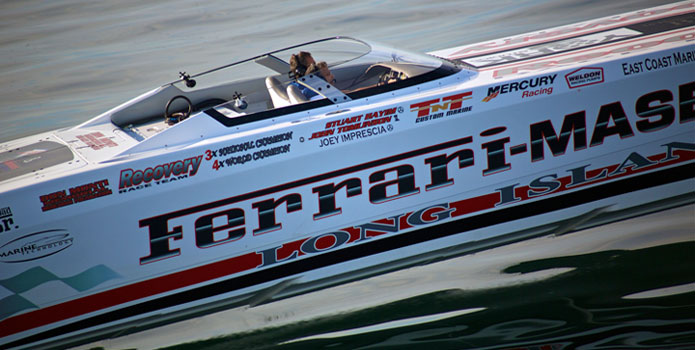Fuel System Pivotal to Hayim’s Around Long Island Record
Behind the obvious glitz and power of a 42-foot-long Marine Technology, Inc., catamaran with twin Mercury Racing 1350 engines and the incredible good fortune of having great weather and reasonable sea conditions, there was a less-sexy but just-as-important element behind the recent Around Long Island Record set by Stuart Hayim and John Tomlinson on August 8. The boat’s fuel system, which was modified at TNT Custom Marine in Miami, played a pivotal role in their success.
Hayim and Tominson fly to a new Around Long Island record. Photos courtesy/copyright of the National Power Boat Association, the sanctioning body for the run.
A 42-foot MTI cat comes standard with port and starboard fuel tanks—one in each sponson—just ahead of the engine compartment bulkhead. Each tank holds 130 gallons. Tomlinson, the owner of TNT Custom Marine and the throttleman for the run (Hayim drove the boat), knew that wouldn’t be enough for the 270-mile run given the fuel-hungry 1,350-hp engines.
“I did the run from our shop to the Key Largo Bridge twice, which is 71 miles each way, to calculate fuel burn,” said Tomlinson. “I did it at various boat and engine speeds. I knew that we would need more for the run. Plus, I wanted to have 100 gallons of fuel at the end of the run, just in case something happened.”
So Tomlinson and his crew added two 150-gallon fuel cells in the portion of the cockpit that normally would have been occupied by rear bucket seats. To move the fuel from add-on cells to the dedicated fuel tanks below them, they installed four transfer pumps. The cells were secured in aluminum-framed housing and then protected with a cover built in-house at TNT.

“As I could see our fuel level going down on the screen during the run, I kept transferring fuel from the cells to the tanks,” said Tomlinson. “My goal was to get as much fuel as possible from the cells into the tanks as we progressed through the run, because the tanks are lower in the boat. I also over-propped it somewhat so we could run higher speeds at lower rpm. The boat was a little sluggish getting up top, but it was more fuel efficient.
“The system worked perfectly,” he added.
Tomlinson and Hayim started the run with 500 gallons of fuel (They burned 50 gallons the day prior). They finished with 130 gallons—half of the 42-footer’s stock fuel capacity. At the start of the event, when the boat was full of fuel—approximately 3,700 pounds worth—and running wide open, the fuel consumption rate was 170 gallons per hour. Near the end of the run with much of the fuel gone and the now-lighter boat running flat out, the burn rate dropped to 123 gallons per hour, according to Tomlinson.
Tomlinson said he enjoyed the endurance event, and hopes to do another in the near future.
“ I would to do more stuff like this,” he said. “The offshore racing has really kind of slowed down. I have always wanted to do the Miami-Nassau record run. I think that’s the one to go after.”
Related Story


